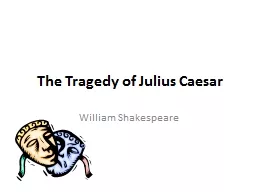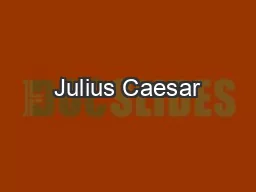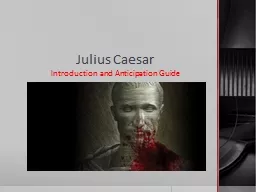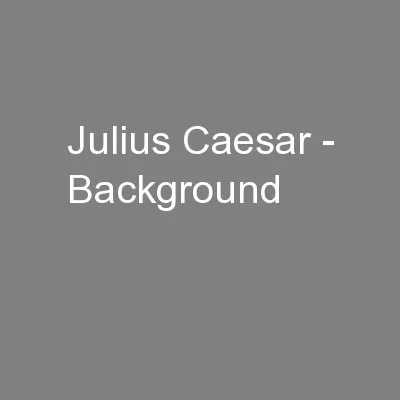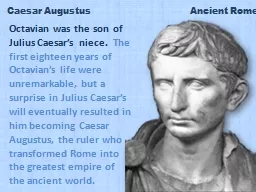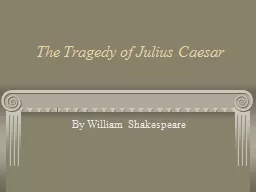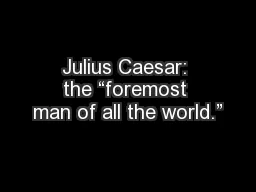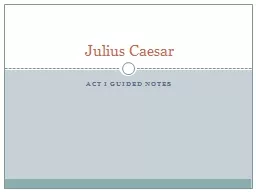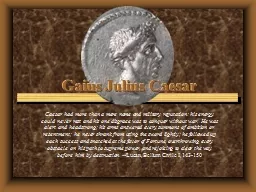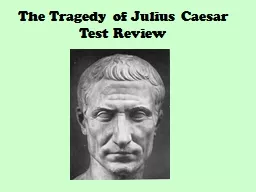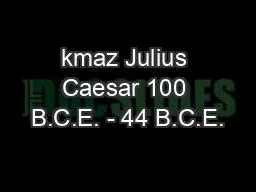PPT-The Tragedy of Julius Caesar
Author : aaron | Published Date : 2017-03-31
William Shakespeare Shakespeares Tragedies Plays that tell of a reversal of fortune from good to bad experienced by a man or woman usually of noble birth Sometimes
Presentation Embed Code
Download Presentation
Download Presentation The PPT/PDF document "The Tragedy of Julius Caesar" is the property of its rightful owner. Permission is granted to download and print the materials on this website for personal, non-commercial use only, and to display it on your personal computer provided you do not modify the materials and that you retain all copyright notices contained in the materials. By downloading content from our website, you accept the terms of this agreement.
The Tragedy of Julius Caesar: Transcript
William Shakespeare Shakespeares Tragedies Plays that tell of a reversal of fortune from good to bad experienced by a man or woman usually of noble birth Sometimes based on historical characters . Background:. . For centuries, Romans debated and even fought civil wars while trying to decide whether a monarchy, a republic or a dictatorship was the best form of government. . In 60 B.C., a triumvirate (a 3-man rule) of Caesar, Crassus, and Pompey was formed to govern Rome.. True or False?. True or False?. Cassius influenced . Brutus to join the . conspiracy. .. True. Cassius advised the conspirators to kill both Caesar AND . Antony. True. Portia had a terrible dream and advised her husband not to go to the senate that . Introduction and Anticipation Guide. …Rome was the light of the world, and . the Roman Empire was the work of the gods. Julius Caesar: An Historical Play. The . Tragedy. of Julius Caesar, also known simply as Julius Caesar, is a tragedy by William Shakespeare, believed to have been written in 1599. In . the 6th C. . B.C.E., . Rome was ruled by a . family of brutal tyrants called the . Tarquins. . Led by . Lucius. Julius Brutus, the Romans fought against the monarchy . and . established . Rome as a . Octavian was the son of Julius Caesar’s niece. . The first eighteen years of Octavian’s life were unremarkable, but a surprise in Julius Caesar’s will eventually resulted in him becoming Caesar Augustus, the ruler who transformed Rome into . By William Shakespeare. Ideas to Consider as We Read…... Most people resent others’ power….. Sometimes being superstitious is a good thing….. No cause, political or other, is worth dying for…. pp.115. 1.. Getting acquainted with Shakespeare. 2. A look at Shakespeare. ’. s London. 3. The Elizabethan Theater - The Global Theater . 4. Biography of Julius Caesar and brief historical overview. SIT . NEAR YOUR NORMAL SEAT!. Pick up the paper(s) by the door.. Update your ToC:. 88: Notes – Fall of the Republic/Rise of Caesar. 89: Julius Assassination Twitter Activity. Write down your HW. :. Scene . i. , Preview. Two characters, Flavius and . Marullus. , are walking the streets of Rome where many citizens are celebrating Caesar’s triumph over Pompey. They run into two men, a carpenter and a quick witted cobbler, and inquire about their garb. The commoners are celebrating Caesar’s return, and Flavius and . The Play. The Characters. Julius Caesar – The Real Man. A historic figure who lived from 100 to 44 BC. Military Leader and Ruler of Rome. Statues currently exist in museums today. Caesar’s biography was written in . Gaius Julius Caesar Caesar had more than a mere name and military reputation: his energy could never rest and his one disgrace was to conquer without war. He was alert and headstrong; his arms answered every summons of ambition or resentment; he never shrank from using the sword lightly; he followed up each success and snatched at the favor of Fortune, overthrowing every obstacle on his path to supreme power, and rejoicing to clear the way before him by destruction. -- Test Review. Section I: Name the character (10 points) . H. as . a dream that Caesar’s statue is flowing with . blood. Calpurnia. B. . . Convinces . Caesar to go to the . capital. Decius. C. . . Warns . Veni. Vidi. Vici.. I came. I saw. I conquered.. How many words can you think of that are associated with . Julius Caesar. ?. Caesar Salad. Orange Julius . Caesarian Section (C-Section). July!. Little Caesar's Pizza . Veni. Vidi. Vici.. I came. I saw. I conquered.. How many words can you think of that are associated with . Julius Caesar. ?. Caesar Salad. Orange Julius . Caesarian Section (C-Section). July!. Little Caesar's Pizza .
Download Document
Here is the link to download the presentation.
"The Tragedy of Julius Caesar"The content belongs to its owner. You may download and print it for personal use, without modification, and keep all copyright notices. By downloading, you agree to these terms.
Related Documents

